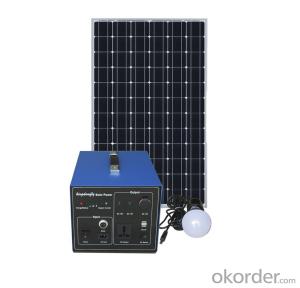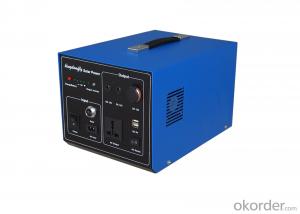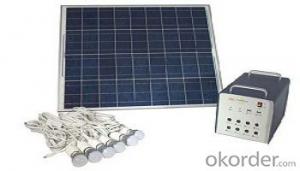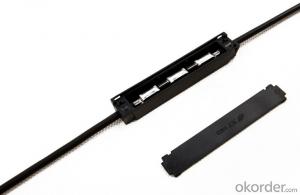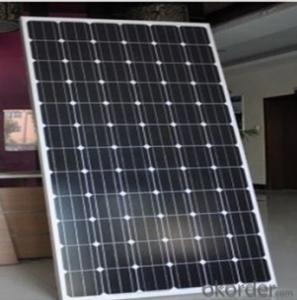Portable Solar Lighting System Hot Selling SPS_80W
- Loading Port:
- China main port
- Payment Terms:
- TT OR LC
- Min Order Qty:
- 3 pc
- Supply Capability:
- 10000 pc/month
OKorder Service Pledge
OKorder Financial Service
You Might Also Like
Main Information
SPS_80W This product is high performance,family used portable solar power system,which can receive energy and store it in battery outside connected to SPK by solar energy on sunny day,and supplies electric power for varies appliances such as electric fan,lighting lamps, television, portable computer etc.It can supply power for both DC and AC electric application .It’s very helpful and useful for home electric supply.
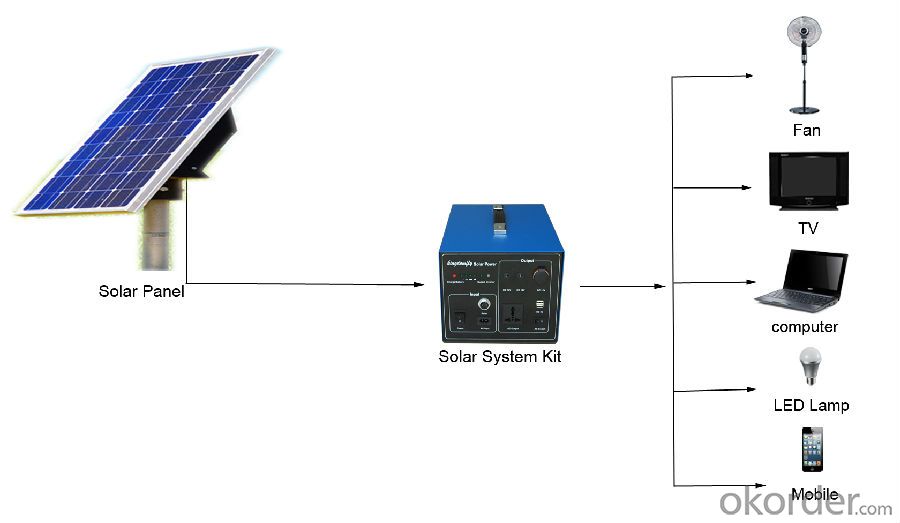
Features
◆ Both Solar charge input and AC charge input.
◆ Both DC and AC output
◆ Solar Feedback Circuit Protection
◆ Output Short-circuit Protection
◆ Solar「+」「-」anti-access protection
◆ Output「+」「-」anti-access protection
◆ Over Charged Protection
◆ Over Discharged Protection
◆ Over Load Protection
◆ Over-Temperature Protection
Technical parameters
Specification | Value/Material | |
Item No. KDF | SPS_80W | |
Solar Recommended | Specification | Poly silicon |
Working Voltage/Power | 18V80WP | |
Battery | Rated Voltage/Capacity | 12V40AH |
Cycle Number | 80% Deep Cycle Number:500 70% Cycle Number:800 | |
Working Temperature | Short Period(one Month):-20~50℃ Long Period(Six Months):-10~45℃ | |
Charging Controller | Operating Voltage | 12V |
Input Voltage | 17.3V~21V | |
Input current | MAX:10A | |
Power Consumption | MAX: 5mA | |
Low Voltage Disconnect(LVD) | 10.8V | |
Low Voltage Reconnect(LVR) | 12.3V | |
High Voltage Discharge( HVC) | 14.6V | |
High Voltage Recharge(HVR) | 13.8V | |
Temperature Protection | 60℃ | |
DC Output | DC output & Application | USB 5V1A*2 |
DC output & Application | DC 12V1*4A | |
AC Output | Output Wave | Modified Wave |
Input Voltage | 11V~15V | |
Output Voltage | 110V±10% | |
Output Frequency | 60Hz±2Hz/50Hz±2Hz | |
Rated Output Power | 300W/500W | |
Maximum VA | 600VA/1000VA | |
Maximum Efficiency | 88% | |
Temperature | 0-40℃ | |
Over Temperature | 60℃~70℃ | |
Low Voltage Alarm | 11V | |
Low Voltage Shut off | 10.5V | |
High Voltage Shut off | 16V | |
Package | Set size | 328*252*267mm |
Set N·W | 11.6kg | |
Set N·W | 12.8kg | |
- Q:Can solar energy systems be used for powering streetlights?
- Yes, solar energy systems can be used to power streetlights. Solar panels can be installed on top of streetlights or nearby structures to capture sunlight and convert it into electricity. This energy can then be stored in batteries or used immediately to power the streetlights during the night. Solar-powered streetlights are an eco-friendly and cost-effective alternative to traditional grid-powered lights.
- Q:Can solar energy systems be used in areas with high levels of dust or sandstorms?
- Solar energy systems can indeed be utilized in regions with significant amounts of dust or sandstorms. Although these natural occurrences can momentarily decrease the efficiency of solar panels by obstructing sunlight, there are various steps that can be taken to mitigate their impact. Firstly, it is crucial to regularly clean and maintain solar panels to eliminate accumulated dust and debris, ensuring the maximum absorption of sunlight. This can be achieved through manual cleaning or by utilizing automated cleaning systems that employ water or brushes to keep the panels pristine. Secondly, there are advanced panel designs and coatings available that minimize the adherence of dust particles and facilitate effortless cleaning. These technologies enable panels to self-clean or reduce the accumulation of dust, guaranteeing optimal performance even in dusty environments. Additionally, proper installation and positioning of solar panels play a significant role in minimizing the impact of dust or sandstorms. By tilting the panels at an appropriate angle and maintaining sufficient ground clearance, the accumulation of dust can be minimized. Furthermore, employing protective measures such as fences, windbreakers, or enclosures around the solar energy systems can shield the panels from strong winds and blowing sand during sandstorms. These measures effectively prevent physical damage to the panels and maintain their functionality. In conclusion, although dust or sandstorms may present temporary obstacles to solar energy systems, with proper maintenance, cleaning, panel design, positioning, and protective measures, solar energy can still be effectively harnessed in areas with high levels of dust or sandstorms.
- Q:How do solar energy systems affect the installation of satellite dishes?
- Solar energy systems can potentially affect the installation of satellite dishes by obstructing the line of sight between the dish and the satellite. It is important to carefully plan and position both the solar panels and satellite dish to ensure they do not interfere with each other.
- Q:Can solar energy systems be used for powering off-grid eco-cities?
- Yes, solar energy systems can definitely be used to power off-grid eco-cities. Solar panels are a sustainable and renewable energy source that can efficiently generate electricity from sunlight, making them ideal for eco-friendly communities. By installing solar panels on rooftops or in open spaces, off-grid eco-cities can harness the power of the sun to meet their energy needs. Additionally, advancements in battery storage technology allow for the storing of excess solar energy, ensuring a continuous power supply even during periods of low sunlight. Overall, solar energy systems offer a viable and environmentally friendly solution for powering off-grid eco-cities.
- Q:What is the role of charge controllers in a solar energy system?
- The role of charge controllers in a solar energy system is to regulate and control the flow of electricity between the solar panels and the batteries. They prevent overcharging of batteries by regulating the voltage and current, which helps prolong the battery's lifespan and ensures efficient and safe operation of the entire system.
- Q:How do solar energy systems impact waste reduction?
- Solar energy systems can greatly impact waste reduction by reducing the reliance on fossil fuels for electricity generation. As solar power harnesses energy from the sun, it eliminates the need for burning fossil fuels, which reduces the production of harmful greenhouse gases and air pollutants. Moreover, solar energy systems have a long lifespan and require minimal maintenance, resulting in reduced waste associated with traditional energy sources like coal or natural gas. Overall, solar energy systems play a significant role in minimizing waste and promoting a cleaner and more sustainable future.
- Q:How do solar energy systems affect air conditioning costs?
- Solar energy systems can significantly reduce air conditioning costs. By harnessing the power of the sun to generate electricity, solar energy systems can offset the energy consumed by air conditioning units. This means that during peak cooling seasons, when air conditioning usage is high, the solar energy system can help reduce the burden on the grid and lower electricity bills. Additionally, solar energy systems can be designed to directly power air conditioning units, eliminating the need for grid electricity altogether. Overall, solar energy systems can provide efficient and cost-effective cooling solutions while reducing the environmental impact of traditional air conditioning systems.
- Q:Can a solar energy system withstand extreme weather conditions?
- Certainly, extreme weather conditions pose no challenge for a solar energy system. Solar panels boast a sturdy design that enables them to endure diverse weather phenomena, such as scorching heat, freezing cold, fierce winds, heavy downpours, and even snowfall. These panels are crafted with tempered glass and often undergo rigorous testing to ensure their resilience against hailstorms or excessive snow loads. Moreover, solar panels are securely installed to withstand powerful gusts and are engineered to resist corrosion. In essence, although extreme weather conditions may slightly affect solar energy production, solar energy systems are purposefully constructed to persist and function optimally in various weather conditions.
- Q:How do solar energy systems contribute to reducing the risk of electrical fires compared to traditional power generation methods?
- Solar energy systems contribute to reducing the risk of electrical fires compared to traditional power generation methods because they do not rely on flammable fossil fuels or complex mechanical systems. Solar panels convert sunlight directly into electricity, eliminating the need for fuel combustion or extensive electrical wiring. This significantly reduces the risk of accidental fires caused by fuel leaks, short circuits, or electrical malfunctions, making solar energy systems a safer and more reliable alternative.
- Q:Can solar energy systems be used for powering public transportation systems like buses or trains?
- Yes, solar energy systems can be used for powering public transportation systems like buses or trains. Solar panels can be installed on the rooftops or in dedicated areas near the transportation infrastructure to generate electricity from sunlight. This renewable energy can then be used to charge the electric batteries of buses or trains, reducing their reliance on fossil fuels and lowering carbon emissions. Additionally, solar-powered charging stations can be set up along the transportation routes to ensure continuous energy supply.
1. Manufacturer Overview |
|
|---|---|
| Location | |
| Year Established | |
| Annual Output Value | |
| Main Markets | |
| Company Certifications | |
2. Manufacturer Certificates |
|
|---|---|
| a) Certification Name | |
| Range | |
| Reference | |
| Validity Period | |
3. Manufacturer Capability |
|
|---|---|
| a)Trade Capacity | |
| Nearest Port | |
| Export Percentage | |
| No.of Employees in Trade Department | |
| Language Spoken: | |
| b)Factory Information | |
| Factory Size: | |
| No. of Production Lines | |
| Contract Manufacturing | |
| Product Price Range | |
Send your message to us
Portable Solar Lighting System Hot Selling SPS_80W
- Loading Port:
- China main port
- Payment Terms:
- TT OR LC
- Min Order Qty:
- 3 pc
- Supply Capability:
- 10000 pc/month
OKorder Service Pledge
OKorder Financial Service
Similar products
New products
Hot products
Hot Searches
Related keywords
